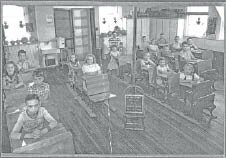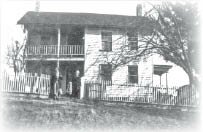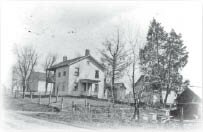
Discover rewarding casino experiences. 
|
Singing schools were a popular self-entertainment back when with folks, adults and children learning harmony and to read music. Plays such as “Ten Nights in a Barroom,” a stylish temperance drama that often ran to two performances, not just one. Topics at debates were such as “Was Greek democracy the Same as Ours Today?” or “Should Girls Ride Bicycles?” A wide variety as you can see. Spellers were cuthroat. One team that traveled all over the county to compete, would position themselves at four different locations around the room so as not to receive the same word another team member might miss. Strategy, eh! Enjoyment in life was found with one another and in simple homemade “bees” and games with neighbors. The few houses left at Georgetown can still be read as close-knit and helpful of one another. The first schoolhouse may have been in someone’s home or a crude log cabin but among those who used it where the local Methodists who then moved congregation into where it was rumored a town would finally be platted, Lanark, but it lay east of it as what was the Sherwood(?) Grissinger school, later the Rock Creek Township maintenance building. When the plat of Lanark included the entire of Section 5, not Georgetown or at Sherwood’s Corner, the Methodists set sights on the southeast edge of five and located church and cemetery there. It later was taken over the by the city of Lanark with the church moving to the city proper.
Schools were often used as community halls and Georgetown’s was also. The picture here is a view of the classroom, October 31, 1950. Recognize anyone? It was given by Helen Derrer, now of Mt. Carroll. She also contributed an essay concerning a notable event that occurred from the Georgetown Cherry Grove Church of the Brethren (later in this article). The school stands though it has been moved slightly from this original site and is a residence, remodeled and added onto. Perhaps a surprise to you. Behind it once was a small cemetery, now abandoned. No one is certain if the graves were moved to the Brethren cemetery down the road, or not. But in 1861 the Cherry Grove Church was constructed by the eastern-most members of the Arnold’s Grove Church about five-six miles west. The Arnold’s Grove people had been so devout and earnest, and faithful, that their congregation had grown so that it had outsourced the building. Parts of that story has been told here but such had been the numbers that traveled distances that it was decided to split into three other congregations, Hickory Grove (Wacker), Dutchtown (near Milledgeville), and Cherry Grove where in 1861 the members constructed the basic 40’ x 60’ meeting house, meaning that it, too, like Lanark, is observing its 150th anniversary. Many of the settlers coming in the 1830’s and ‘40’s were “Dunkards,” as they were called because their baptism was by immersion, not just “sprinkling,” Some of them were influential in setting county on its way. David Emmert, for instance, who became the first minister at Arnold’s Grove but who with partnership built the first courthouse with the clause that a room should always be available in which to hold church services after years of meetings being held in homes and barnyards. The Arnold’s Grove Church was built in 1854. Three years later ninety-six members had joined the church besides those settled here already. The congregation grew steadily until it was decided to split into the three county-wide parishes. Of the Georgetown church, the author of the 1878 history said of the village, “Notwithstanding those who have moved or have died, the Cherry Grove membership stands at 225. That congregation is noted for large numbers and its activity in mission work” ... In 1878 the writer stated that “Three years before, 1875, the Cherry Grove church took action that affected the entire brotherhood throughout America.”
Living in Lanark at the time was a Danish emigré, a harness maker by trade, who had fled Denmark for speaking out against the state-controlled Lutheran church. He went first to Norway, then came to the States, met Mary Nielsen whom he married and they then came West to Clinton, Iowa and then Rock Island where chance conversion made him aware of a church at Hickory Grove (Wacker) which practiced a religion such as that he’d been seeking ... As in the New Testament. It’s pastor, George Zoellers, guided Christian Hope, an appropriate name, you see, and he came to Lanark in 1874 where he opened a harness business and after hours worked zealously in translating Brethren pamphlets into Danish. He hoped to send them back to Denmark. With a 25¢ donation, he began collecting money for that project and finally was able to have them printed at a print shop at the south end of Lanark’s commercial district, 121 South Broad where Zier’s Garage was a long-time tenant. In a few years it became the Brethren Publishing House, an important department of that denomination’s outreach that later moved to Elgin via Mt. Morris, a story to be told at a later date! Meantime, a Danish pastor wrote to ask if the Brethren could send a minister to Europe to give the message of their precepts. This excited the Cherry Grove people who had been interested for some time in missionary work. With eleven other churches in the district come together November 15, 1875 it was voted to support the first foreign missionary from their church denomination to spread the Biblical message. It was voted to send Mr. & Mrs. Enoch Eby and Mr. & Mrs. Daniel Fry
|






